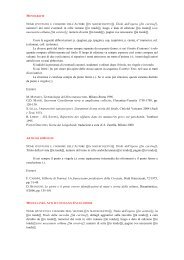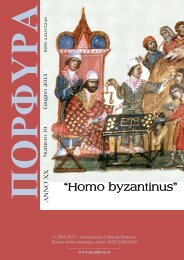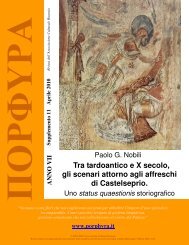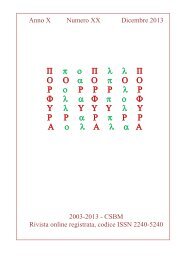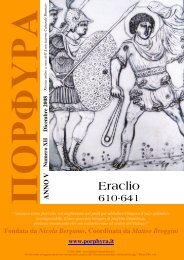ΠΟΡΦΥΡΑ - Porphyra
ΠΟΡΦΥΡΑ - Porphyra
ΠΟΡΦΥΡΑ - Porphyra
You also want an ePaper? Increase the reach of your titles
YUMPU automatically turns print PDFs into web optimized ePapers that Google loves.
A Prôtospatharios, Magistros, and Strategos Autokrator of 11 th cent.<br />
the equipment of Georgios Maniakes and his army according to the Skylitzes Matritensis miniatures<br />
and other artistic sources of the middle Byzantine period.<br />
gold interwoven embroidery (χρυσοχλαβοs 229 ) ; these cuffs,<br />
heavily embroidered and decorated also with pearls, applied<br />
separately on the wrist and on the lower edges of the tunic,<br />
could be recycled for other dresses, like the ταβλιον and the<br />
cloak’s embroidery 230 .<br />
The cuirass (fig. 11 n. 26,29) looks in the enamel as if it<br />
is either lamellar or scale κλιβανιον of Greek-hellenistic<br />
fashion 231 , i.e with a slightly muscled shaped base. We have<br />
reconstructed it as scale armour with 10 rows of quadrangular<br />
iron lamellae (πεταλα) 232 , applied at the front and at the back<br />
with a double anchorage system, and placed it on a leather old-<br />
Roman fashion corselet; the πεταλα 233 were fastened directly<br />
on the leather base by means of leather-laces going through the<br />
two parallel holes of each lamella, so as to form overlapped<br />
rows of iron arranged as roof tiles. The leather body presents<br />
borders of coarse silk, cotton and hardened leather with small<br />
tongues (cymation or κρεµασµατα) and felt strips (πτερυγεsκαβαδια−κρεµασµατα)<br />
hanging from sleeves and waist. The<br />
cuirass is formed by two compact valves (at front and back) with<br />
openings on both sides and shoulders linked by straps closed<br />
through metallic hooks (fig.11 n. 27-28) 234 .<br />
typical for all East-Roman history, and performed by experts in this kind of magnificent artwork. S. See Du Cange<br />
Commentarii Pseudo Codinus pp. 221 f. and the following note.<br />
229 Litterally: the golden clavus. Clavi were stripes worn by Roman soldiers, dignitaries, officers, on tunics and dresses,<br />
and the material used as well the extravagante preciousness was indicative of rank. The golden stripes were reserved for<br />
senior officers but were also a prerogative of people who could afford to buy them; the work was realised by specialist<br />
workers in Constantinople, called χρυσοκλαδαριοι. Cfr. Kletorologion of Philotheos, in Oikonomidès, Les listes, p.<br />
133 and note 99 ; p. 170 note 153, about the σπεκια (kind of military tunics) χρυσοχλαδα of the Imperial Guardsmen<br />
mentioned in De Cer. I, 82 ; p. 317. In the work of Theophanes, I, 469, is mentioned the destruction by fire of the<br />
laboratory of these workers in the third year of Constantine the 6 th (25 december 792). S. Du Cange commentarii<br />
Pseudo Codinus pp. 221 f. ; Du Cange, Glossarium, col. 1769 ; A very fine specimen of the 11 th golden thread for tunic<br />
or mantle coming from Byzantium is preserved in Saint Petersburg Hermitage and published in Various, Byzantine Art<br />
in CCCP collections, Moscow 1977, 2 vol., in Russian, fig. 671 p. 131-132.<br />
230 As in the late Roman Empire: s. Mcdowell S., Late Roman Cavalryman, 236-565 AD, London 1995, p. 53; Antinoe,<br />
100 anni dopo, pp. 189, 219ff.<br />
231 Mrs. Hoffmeyer distinguished among two types of support for the scale/lamellar armour: the eastern one, without<br />
exterior signs of Greco-Roman heritage, and the Hellenistic one, with slightly muscled accent and lambrequins on the<br />
shoulders and under the waist. See Hoffmeyer, Military Equipment, pp. 56-63 and our note n. 72 above.<br />
232 If the choice of the reconstruction has been had the lamellar one, we should reconstruct the armour as a purely<br />
lamellar κλιβανιον (with lamellae looking upwards) superposed to an half-anatomical zoupa. This was the<br />
undercorselet for excellence in middle Byzantine period, made of linen and cotton, as mentioned by Achmet,<br />
Oneirokriticon, 225, p. 177. S. also Du Cange, Glossarium, col. 466. The word gives origin to the word giubba or<br />
giubbone in italian language, as distinctive military dress, a padded protection worn by soldiers in modern times. A<br />
good specimen of lamellar corselet worn over a zoupa is visible in the warriors of the Hermitage Tryptikon, s. Bank,<br />
Byzantine art, fig. 126. I must thank Dr. Dawson for the note of this detail. The fact that fig. 10 shows black strips<br />
among the rows of the lamellae suggests the presence of leather, and is indicative of a lamellar construction of this<br />
armour, made by lamellar rows which each row separated by the backing leather. About Zoupa cfr. also Dawson,<br />
Suntagma Hoplon, note 10.<br />
233 The prototypes used in our reconstruction are published in Vitlyanov, The old Bulgarian armament, pl. XXVIII fig.<br />
19 ; they are 3cm. of lenght.<br />
234 The buckles and the hooks used are from specimens from Garvan-Dinogetia, s. Stefan-Barnea, Dinogetia, pp. 295,<br />
297-298 figg. 173 nn. 17-18 ; the first of these specimen (3x2 cm.) belongs to the so called “lyre” type, and<br />
archaeologists adscribe his origin into the Russian-Byzantine commonwealth ; similar specimens were found in Pliska<br />
and dated to the 11 th century after the period of the East-Roman conquest, cfr. Stantchev S., Fouilles et materiaux<br />
38



